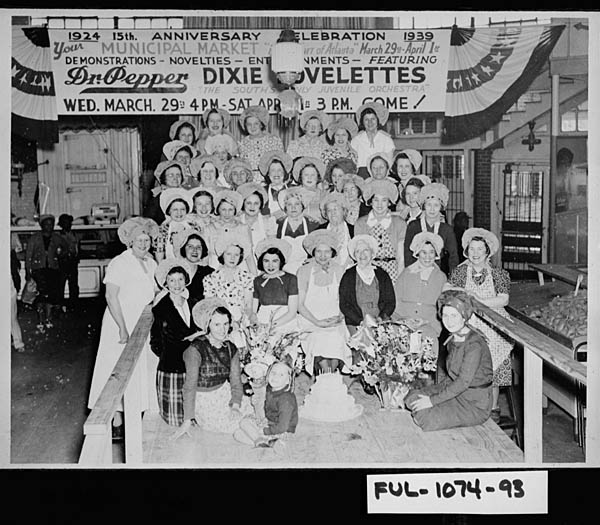The Sweet Auburn Curb Market is a historic market located in downtown Atlanta . In 1918 Atlanta established a “curb market” on land cleared by the Great Atlanta Fire of 1917. This fire decimated the Old Fourth Ward of Atlanta, destroying almost two thousand homes and leaving over ten thousand Atlantans, mostly blacks, homeless.[1] After the fire a tent market occupied the site.

Corner of Edgewood and Bell, Atlanta 1911-1925, before the Great Atlanta Fire of 1917 sheet 453, Sanborn Fire Insurance Maps.
The Atlanta Women’s Club raised money for a fireproof brick and concrete building. It was designed by architect, A. Ten Eyck Brown and opened on May 1, 1924 as the Municipal Market of Atlanta. The Municipal Market is owned by the city. The market was located in the center of Atlanta and became the largest single market for farm products in the state. It is one of the few remaining city markets in the country.[2] It was initially very successful. It gave urban consumers access to fresh farm products and provided a market for local farmers. It served all kinds of customers, black and white, rich and poor. White ladies from Buckhead would send their chauffeurs in to pick up special cuts of meat and farm fresh produce.

Municipal Market of Georgia taken from the June 1924 edition of the City Builder, VIS 170.613.001, Kenan Research Center, Atlanta History Center.
In the early years of the Municipal Market all the official vendors were white as this was the Jim Crow era in the south. There was no listing of any black vendors in the Atlanta City Directories during the early years. Blacks could enter the market for shopping but black vendors had to do all their business from the curb until desegregation in the 1960s. This is how the market got its name “The Sweet Auburn Curb Market.” There is no mention of the Municipal Market in Calloway’s oral history of “Sweet Auburn Avenue” business history.[3]
The Early Years
The Municipal Market was first operated under an agreement with the city of Atlanta which expired in 1973. A copy of a lease to A.M. Hardeman for stall 46 to be used for Georgia Farm Products was signed on December 22, 1923 for one year to begin at the completion of the building. The rent was $12.00. Larger spaces were also available as Kuhns Bros. signed a lease for Stalls 61-71 for Georgia Farm Products for $25 on the same date.[4]
The market became a center for promoting local products. The Atlanta Daily World, the cities African American Newspaper, was very supportive of the market. They published 12 recipes provided by the market; all “tested by the Georgia State Department of Agriculture.” The recipes featured local produce. They encouraged their readers to “Use Georgia Products and Help Georgia.”[5] The Atlanta Daily World also covered the celebration of “Pear Week” at the market which featured cooking demonstrations by specialists from the Georgia State Agricultural Extension service, free samples, recipes, and souvenirs. “It’s Pear Time in Georgia” was the slogan and it was pointed out that using pears helps “farmers earn more money” and “many Georgians save money.” The Atlanta Daily World stated “It is a patriotic duty to eat Georgia pears.” Raffle prizes including a basket of pears, pear honey, and six pounds of Dixie Crystal sugar were awarded. The newspaper pointed out “colored” individuals were the recipients of some of the prizes.[6]
Panoramic View of the Market in 1949 ,VIS 101.576.032, Kenan Research Center, Atlanta History Center.
Starting in the 1950s changes in downtown Atlanta have affected the market. These changes include: construction of I 75 and I 85, the expansion of Georgia State University, the development of the Martin Luther King Historic District, downtown construction, and increased need for downtown parking. People moved out of downtown as housing became scarce. Supermarkets became popular and the market lost much of its customer base.
In the 1970s the market’s 50 year lease was set to expire. Decisions had to be made about the future of the market. Vendors were reluctant to reinvest in improvements because of uncertainties about the lease. There were increasing concerns about the physical condition of the market, health and safety standards, as well as the market’s financial viability. Mayor Sam Massell stated that he would not support a new lease because the market had “outlived its usefulness” and the “city shouldn’t be in the business of running a grocery store with taxpayers’ money.” He pointed out that the original purpose of the market was to provide a place for local farmers to market their goods. Those days were over as there were no more local farmers. He pointed out that the city should be collecting $100,000 a year from the market but was only getting minimal returns from the business licenses and taxes.[7]
Loyal supporters launched a “Save the Market” campaign in 1973. They pointed out that this unique market served many black, low income customers and was probably the largest “soul food shopping center” in the country. It had annual sales of $2.8 million; had more sales volume than Lenox Square shopping center; and had potential as a tourist destination.[8] The market featured products that were hard to find elsewhere including “country cuts” of pork and beef, oxtail, chitlins, sow belly, turtle meat, frog legs, Australian rabbits, white clay (Kaolin) and yellow root.[9] [10] [11]
Unique Products
Meat, Fish , Produce and “Soul Food”
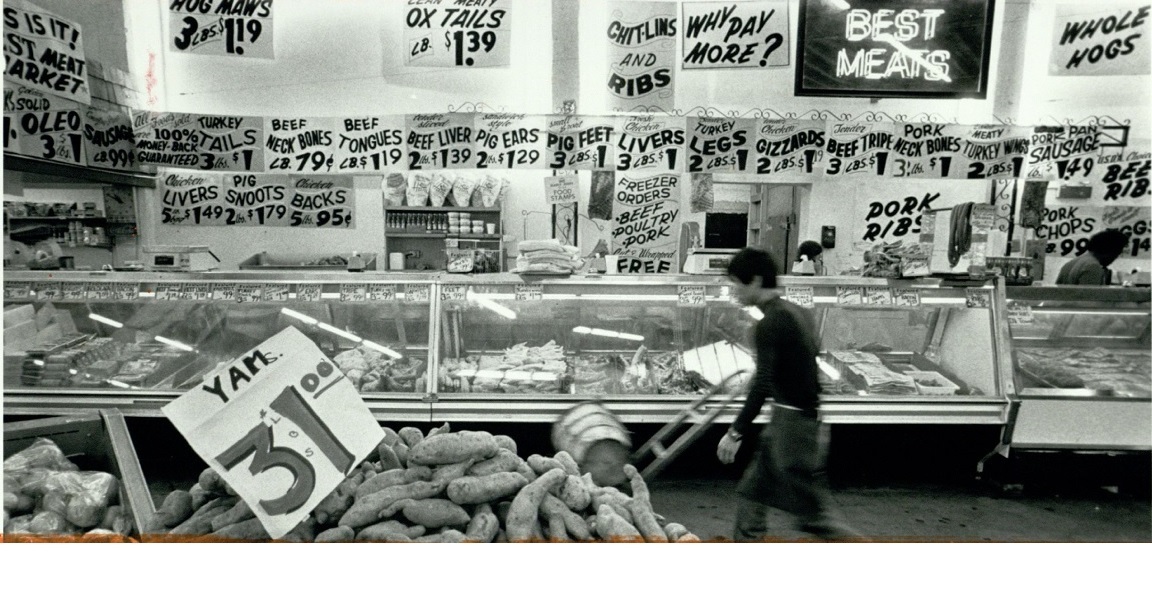
Meat Market, July 7 1983, AJCP 144-011i, Atlanta Journal Constitution Photographic Archive, Special Collections and Archives, Georgia State University Library.
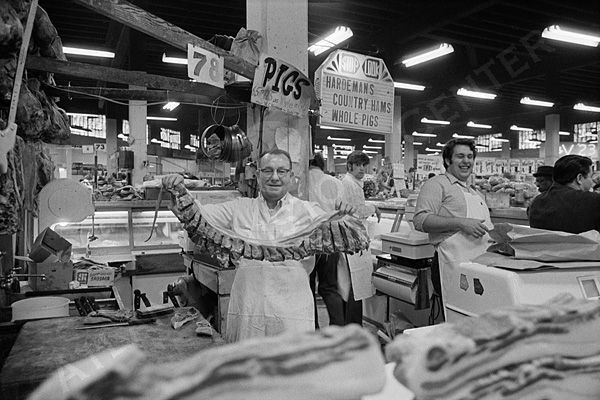
Butcher at Hardeman’s Meat Market, 1970, VIS 101.708.016, Boyd Lewis, Photographer, Kenan Research Center, Atlanta History Center.
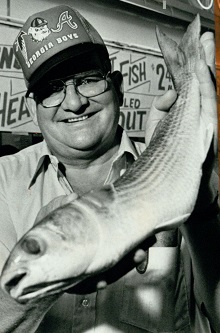
Roy’s Seafood Market with Owner, Roy Tinsley, July 7, 1983, AJCP 144-011z, Atlanta Journal Constitution Photographic Archive, Special Collections and Archives, Georgia State University Library.
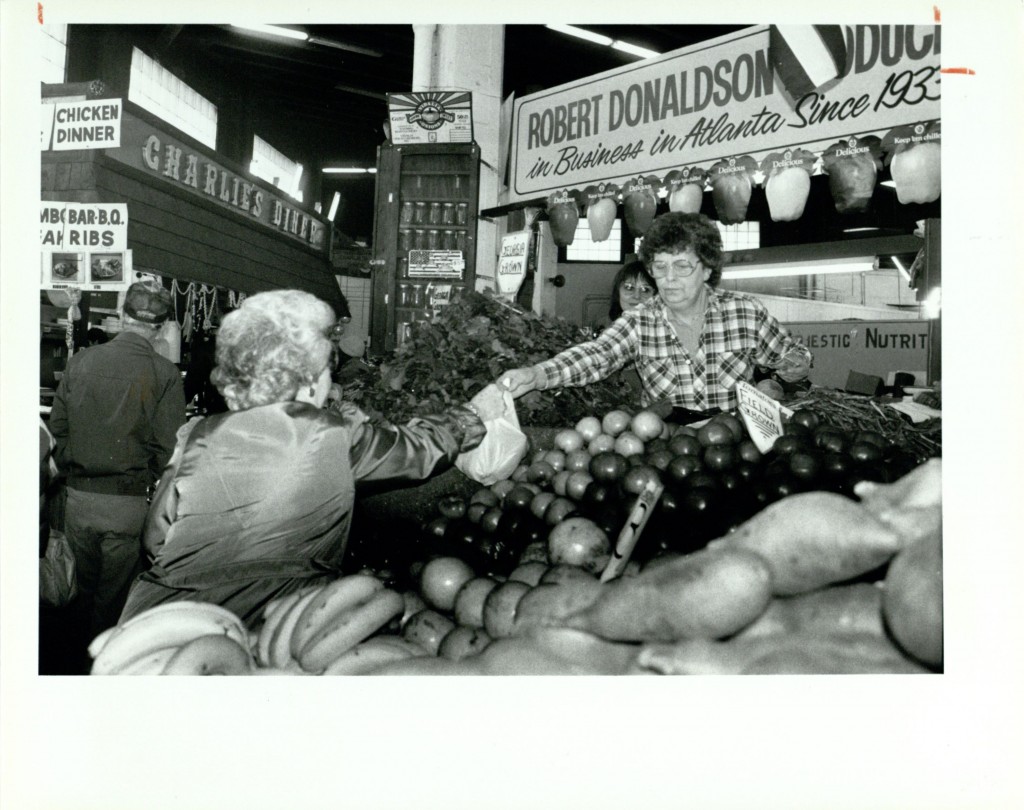
Robert Donaldson’s Produce Stand, April 4, 1991, AJCP 144-011j Atlanta Journal Constitution Photographic Archive, Special Collections and Archives, Georgia State University Library.
A consortium of banks came up with a $1,050,000 loan to clean up and renovate the market. To get this loan thirty-three of thirty-six vendors signed the long term leases that doubled or tripled the monthly fee per square foot rental. Officials agreed to an 18 point list of standards the market must reach including continued rat extermination and daily sanitation inspections.[12] Just before the loan was finalized The Food and Drug Administration filed a law suit to get a court order to close the Municipal Market citing unsanitary conditions including “rodent excreta pellets, apparent rodent nesting material and rodent tracks” and “raw sewage overflowed on the floor and in open trenches.”[13] However Judge Newell Edenfield delayed the hearing until the loan was finalized, stating “It’s been filthy since 1930 and it ain’t going to kill us by Monday.”[14] The market was saved.
Sales improved but the Market was not competitive and patronage began to decline. The city bought the facility in the 1980 and was responsible for its oversight.[15] There were charges of racism and mismanagement.[16] Problems identified included: lack of parking, lack of a marketing plan (a 1992 survey showed that 60 percent of local residents didn’t know the market was there), minimal advertising, and an unsafe neighborhood.[17] In addition there were cultural differences between customers, primarily local, blacks of low and moderate income and the primarily immigrant Korean merchants.[18] In 1993 there were only two African-American-owned businesses in the market.[19] By the 1990s the 1923 building was badly in need of renovation and repairs. Civic leaders again began to question its viability.
Fortunately for the market, Atlanta was selected to host the 1996 Summer Olympics. This generated a campaign to spruce up the city for the event and an influx of cash to support the effort. Inner-city revitalization was identified as a priority. The Municipal Market, now renamed the Sweet Auburn Curb Market, eventually received about $8 million for renovations. The money came from the Department of Housing and Urban Affairs and the Atlanta Empowerment Zone. But the path forward was far from smooth.
The initial $7 million allocated for the renovations was not enough. Renovations were delayed and tenants left leaving only 10 of 37 vending stalls leased. City officials either gave no support or opposed additional funding. President Bush identified the market renovation as “pork-barrel” and ordered the funding cut.[20] In August the market’s board voted to go out of business only to be saved four days later by a $450,000 loan from the federally funded empowerment zone. This decision generated criticism from Marvin Arrington who said “the city spending money there is throwing good money after bad.[21]
However by 1997 the renovations were nearly completed. In celebration, a parade from Woodruff Park down auburn Avenue (“March to the Market”) was held followed by face-painting, storytelling, gospel choirs, bands and an appearance by Mayor, Bill Campbell.[22] The grand reopening was September 26, 1997.[23]
Similar dilemmas have occurred in other cities.[24] The Hamilton Ontario Farmers’ Market was viewed as an “irreplaceable cultural and Historic gem by “traditionalists and condemned as an antiquated institution not worth the land it occupied” by “modernists.” Proposed solutions included reducing, relocating and demolishing the market. The final compromise was a remodeled market below with a parking ramp above a ground.[25] Farmers markets have undergone resurgence in recent times with emphasis on benefits of local foods and authenticity.[26] Historic preservationists and community activists now recognize historic markets as a way to revitalize declining urban neighborhoods.[27]
The Market Today
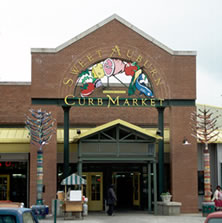
Municipal Market of Georgia taken from the June 1924 edition of the City Builder, VIS 170.613.001, Kenan Research Center, Atlanta History Center.
Today the market is self-sustaining and has showed an increase in revenue for the past two years. It is managed by the Municipal Market Company. Leadership consists of a board of directors approved by the city council. The market is a not-for-profit entity that does not receive any outside defunding other than possible grants.[28] In 2010 the Market received 2 grants totaling over $1.8 million.
The following table documents the changing nature of the businesses at the market from 1927 (54 vendors not counting the black vendors on the curb) to the present, 2015 (25 vendors).
| Business | Year | |||
| 1928 | 1955 | 1985 | 2015 | |
| Meat | 6 | 16 | 9 | 3 |
| Poultry | 4 | 2 | ||
| Seafood | 1 | 2 | 1 | 1 |
| Eateries | 2 | 2 | 2 | 11 |
| Produce | 42 | 14 | 7 | 4 |
| Fruit | 2 | |||
| Grocery Stores | 2 | 5 | 2 | |
| Supermarkets | 1 | 1 | ||
| Bakeries | 2 | 1 | ||
| Dairy | 1 | 1 | ||
| Other | ||||
| Barber | 1 | |||
| Book Store | 1 | |||
| Flowers | 1 | 1 | ||
| Insurance | 1 | |||
| Organics | 1 | |||
| Pharmacy | 1 | |||
| Snowballs | 1 | |||
| Sweets | 1 | |||
| Wigs | 1 | |||
| Total | 54 | 50 | 28 | 25 |
The data show a decrease in produce and meat vendors and an increase in eateries and specialty shops. This reflects the changing neighborhood over the ninety year history of the market. The market no longer serves as an outlet for the products of local farmers. Consumers shop for meat and produce at their local supermarket. Eateries at the market hope to attract customers from nearby Georgia State University, Grady Hospital, tourists visiting the nearby Martin Luther King Jr. Historic Site and Sweet Auburn Historic District. A variety of specialty shops respond to changing consumers interests. The current market is a combination of old and new. There are employees that have worked at the market for 45 years and vendors that have been there for 30 years. A Hardeman signed one of the original leases in 1923 and a Hardeman descendant was interviewed in 1996 over 70 years later.[29]
The market hosts local “pop-up” events for local artisans which contribute to its mission of providing opportunities for small businesses which feature locally made or grown products. A table displaying the merchandise can be set up outside for a minimal fee. Some of the current vendors got their start this way. They first provided free samples and then they began selling from a food truck once a week. Later they rented a stall inside. Six of the current eateries now have a second outside location. One vendor, Miss D., who came right after Katrina, now sells her sweets to major hotel chains (the Hyatt and Marriott) and the airport. The market hopes to attract a grocery store that carries products not sold in the market as the surrounding area is a “food desert.”
The Market has moved into the modern age. It has a web site http://thecurbmarket.com/ complete with blog, a list serve, a newsletter (the Market Insider), and is on Facebook. It is now open on Sundays and hosts Sunday concerts by local jazz groups. It was recently ranked by USA Today as the 16th Best food market around the world. It is a stop on the Atlanta Street Car route and the last stop on the Sweet Auburn Walking Tour which ends with desert and a praline at the market. The Market was recently featured in the New York Times Travel Guide in an article entitled “Atlanta for Kids.”[30] Starting in January 2016 they will have a mini-police precinct in the building. On Feb. 4, 2016 the Atlanta History Center’s lecture series will feature a presentation entitled “Sweet Auburn Market Film Screening and Panel Discussion.” The film maker, representatives from the Southern Foodways Alliance, and vendors from the Sweet Auburn Curb Market will discuss the importance of the market to the city of Atlanta. This is a fitting tribute to the importance of the market past and present.
[1] Gary M Pomerantz, Where Peachtree Meets Sweet Auburn (Penguin Books, 1996), 84-85.
[2] National Register of Historic Places Nomination form for the Sweet Auburn District.
[3] William L. Calloway, The “Sweet Auburn Avenue” business history, 1900-1988/as told by W. L. Calloway (Atlanta?: Central Atlanta Progress), 1988.
[4] Hardeman and Kuhns Bros. leases made available from the files of the “Sweet Auburn Curb Market” by Pamela Joiner, Manager.
[5] “Georgia Products Make Fine Dishes,” Atlanta Daily World, June 30, 1934, 3.
[6] “Free Prizes are Now Being Given at Municipal Market as Pear Week is Celebrated,” The Atlanta Daily World,” Aug 17, 1934, 3.
[7] Sam Hopkins, “New Market Lease Ruled Out,” The Atlanta Constitution, May 29, 1971, 5B.
[8] Jim Merriner, “Market Vendors Sign UP,” The Atlanta Constitution, April 4, 1974, 2A.
[9] Phil Garner, “Is the Municipal Market Doomed,” The Atlanta Constitution, May 9, 1971, SM6.
[10] Jim Stewart, “Municipal Market Decision July 15,” The Atlanta Constitution, July 5, 1973, 8A.
[11] Douglas A. Blackmon, “Incredible edibles in a place with soul long a landmark, Municipal Market due for a facelift,” The Atlanta Journal Constitution,” December 1, 1992, D1.
[12] Jim Merriner, “City Mart Agreement reached,” The Atlanta Constitution, May 3, 1974, 7A.
[13] “U.S. Seeks Order to close Municipal Market,” The Atlanta Constitution,” April 25, 1974, 6A.
[14] Jim Merriner, “Market hearing Delayed,” The Atlanta Constitution, May, 1, 1974. 9A.
[15] S. A Reid, “Facelift may boost Auburn Curb Market,” The Atlanta Journal and Constitution, June 24, 1993, N5.
[16] Douglas A. Blackmon, “Incredible edibles in a place with soul long a landmark, Municipal Market due for a facelift,” The Atlanta Journal and Constitution, December 1, 1992, D1.
[17] S. A. Reid, “Urban Renaissance City hopes market facelift will boost Sweet Auburn But Merchants fear Higher rents’ impact on prices,” The Atlanta Journal-Constitution, June, 24, 1993, D3.
[18]Shelia M. Poole, “Trying Something Fresh; Municipal Market seeks new image, more business,” The Atlanta Journal and Constitution, July 6, 1991, C01.
[19] S. A Reid, “Facelift may boost Auburn Curb Market,” The Atlanta Journal-Constitution, June 24, 1993, N5.
[20] S.M. Pool, “Pork-barrel politics,” The Atlanta Journal and Constitution, April1, 1992, B2.
[21] David Kindred, “We all love this old market, but do we have to save it?,” The Atlanta Journal and Constitution, August 18, 1996, 01C.
[22] H. M. Cauley, “How sweet it is: Market celebrates renovations’ end; March, festivities mark final stages of long overhaul,” The Atlanta Journal-Constitution, April 3, 1997, 09D.
[23] Holly, Crenshaw, “Around Town; Margaret Mitchell, Red Cross worker,” The Atlanta Journal and Constitution, September 25, 1997, 01N.
[24]Alison Brown, “Counting Farmers Markets,” Geographical Review 91, no.4 (October 2001): 655-674.
[25] Danielle Robinson, “Modernizers and Traditionalists in Postwar Hamilton, Ontario: The Fate of a Farmers’ Market, 1945-1965,” Urban History Review 36, no.1 (2007): 45-60.
[26]John Smithers and Alun E. Joseph, “The trouble with authenticity: separating ideology from practice at the farmers’ market,” Agric Hum Values 27(2010) :239–247.
[27] R. M. Neuwirth, “New Interest in an Old Idea: The Rebirth of Framers Markets,” Reprinted without citation in Farmers’ Markets: Establishing Them and Operating Them, edited by D. Holmes. Berkeley, Calif.: Center for Community Futures. This article is cited by Alison Brown in footnote 24.
[28] Pamela Joiner, Manager of the Sweet Auburn Curb Market provided this information.
[29] Charmagne Helton, “Struggling market a wise investment,” The Atlanta Journal and Constitution, August 23, 1996, 01C.
[30] Kim Severson, “In Atlanta, Following in the Footsteps of Dr. King,” The New York Times, May 3, 2015, TR11.
